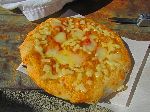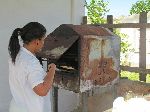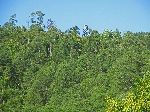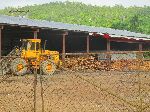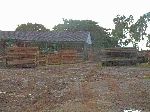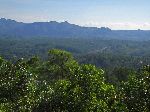| . | ||
Pinar
del Rio
|
||
Mines and Pines |
||
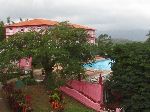 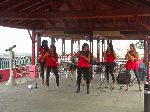 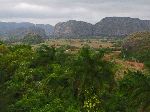 Hotel: This was a capital and energy intensive hotel for the
use of dollar spending tourists. While Cubans don't seem to seek view
property for building their houses, this location was definite selected for
that attribute. As tourist buses passed they would pull-in for five minute
stops so the passengers could enjoy there view. When this happened the
resident ensemble would assemble and perform a few Cuban standards, like
Guantanamera. The PR director for the hotel explained that they offered
an "eco-tourism walk that visited near-by houses and farms." But one
wouldn’t want reality tourism to go too far, after the walk the clients retreat to
what is a fantasy for most Cubans: air-conditioned rooms, manicured lawns, a swimming pool
and more meat at every meal that the Cubans have on their ration card for a
month. Hotel: This was a capital and energy intensive hotel for the
use of dollar spending tourists. While Cubans don't seem to seek view
property for building their houses, this location was definite selected for
that attribute. As tourist buses passed they would pull-in for five minute
stops so the passengers could enjoy there view. When this happened the
resident ensemble would assemble and perform a few Cuban standards, like
Guantanamera. The PR director for the hotel explained that they offered
an "eco-tourism walk that visited near-by houses and farms." But one
wouldn’t want reality tourism to go too far, after the walk the clients retreat to
what is a fantasy for most Cubans: air-conditioned rooms, manicured lawns, a swimming pool
and more meat at every meal that the Cubans have on their ration card for a
month. |
||
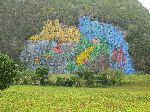 Socialist Art: A cross from the Dos Hermanas
cabins where we are staying is a mural painted on the side of rock face in brown and
primary colors called "Prehistoric Mural." That’s its name and subject, not
its origins. It was painted shortly after the revolution in 1959. It is a mixture of
dinosaurs and early man, but not a particularly compelling or quality rendering. The
Cubans with us took little notice of it and I never heard them mention it. Instead
everyone spent the afternoon around the swimming pool. Socialist Art: A cross from the Dos Hermanas
cabins where we are staying is a mural painted on the side of rock face in brown and
primary colors called "Prehistoric Mural." That’s its name and subject, not
its origins. It was painted shortly after the revolution in 1959. It is a mixture of
dinosaurs and early man, but not a particularly compelling or quality rendering. The
Cubans with us took little notice of it and I never heard them mention it. Instead
everyone spent the afternoon around the swimming pool. |
||
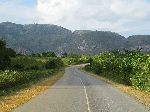 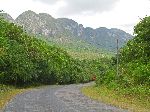 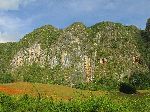 Here
we have opportunities for better view and to learn about the contrasting red
soil and the white limestone mogotes (hills) of the Sierra de los Órganos and
Sierra del Rosario. These mountains parallel the
coastline. There formation is from a fold and thrust of the Guaniguanico
Terrace. The Sierra de los Órganos displays a sequence of exposed Mesozoic
marine limestones and Paleogene marine to continental sedimentary rock. In
the 1800, Manual Fernandez de Castro first found Jurassic marine
invertebrate fossils on a mogote 10km north of the town of Pinar del Rio (Abra
de Ancón). Here
we have opportunities for better view and to learn about the contrasting red
soil and the white limestone mogotes (hills) of the Sierra de los Órganos and
Sierra del Rosario. These mountains parallel the
coastline. There formation is from a fold and thrust of the Guaniguanico
Terrace. The Sierra de los Órganos displays a sequence of exposed Mesozoic
marine limestones and Paleogene marine to continental sedimentary rock. In
the 1800, Manual Fernandez de Castro first found Jurassic marine
invertebrate fossils on a mogote 10km north of the town of Pinar del Rio (Abra
de Ancón). |
||
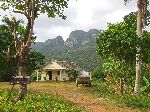 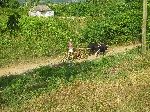 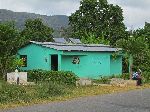 The
is so much detail to be absorbed about how the Cubans live in this area.
Contrasting the more traditional bohio (rural house, traditionally with a
thatched roof) (left) and hauling loads on skids pulled by cows or ox (left),
there is cement block and metal structures. This building (right) has solar
voltaic panels on the roof. The
is so much detail to be absorbed about how the Cubans live in this area.
Contrasting the more traditional bohio (rural house, traditionally with a
thatched roof) (left) and hauling loads on skids pulled by cows or ox (left),
there is cement block and metal structures. This building (right) has solar
voltaic panels on the roof. |
||
 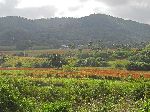 The
land use represents a fairly ecologically aware compromise betweens the needs of
people and preservation of the natural beauty. It may be because there aren't
the economic resources to do otherwise, but the outcome leave great
opportunities for the next century: There is a lot of agriculture on the valley
floor and the mountains have been left forest and natural. The
land use represents a fairly ecologically aware compromise betweens the needs of
people and preservation of the natural beauty. It may be because there aren't
the economic resources to do otherwise, but the outcome leave great
opportunities for the next century: There is a lot of agriculture on the valley
floor and the mountains have been left forest and natural. |
||
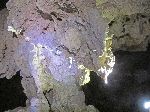
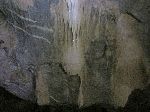
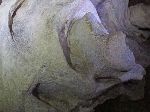
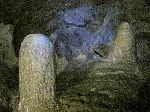
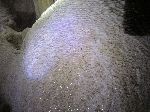 |
||
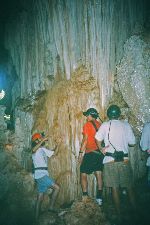 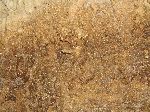 Gran Caverns de Santo Tomas (Moncada)
provides a lesson on Cuba geology and plate
tectonics, from a local expert. It is the second largest cavern formation in
Latin and South America. The program covered the salt intrusion of the base
basalt magmatic rock, fractures and cracks that occurred a during a
subaqueous period and cave fauna; fish, shrimp, crabs and bats. After the
base formation was pushed above sea level, the overlying limestone/calcium
dissolved and seeped through the fracture to form stalactite and
stalagmites, columns, unique helictite (horizontal structure in the center
of the photo to the right), calcium ribbon wall, and dozens of other forms of mineral crystal
formations. Gran Caverns de Santo Tomas (Moncada)
provides a lesson on Cuba geology and plate
tectonics, from a local expert. It is the second largest cavern formation in
Latin and South America. The program covered the salt intrusion of the base
basalt magmatic rock, fractures and cracks that occurred a during a
subaqueous period and cave fauna; fish, shrimp, crabs and bats. After the
base formation was pushed above sea level, the overlying limestone/calcium
dissolved and seeped through the fracture to form stalactite and
stalagmites, columns, unique helictite (horizontal structure in the center
of the photo to the right), calcium ribbon wall, and dozens of other forms of mineral crystal
formations. |
||
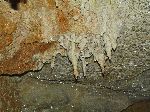 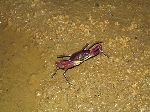 Other
scouring by the ocean and rivers etched and carved
the walls and floor of the cave. In different geological periods the river
that eroded the tunnels
through the lime stone hills was at different levels. There are now seven
levels of tunnels. We climbed up to explore level five, from the Jurassic
Period. It is fascinating how, in some situation, lime and water can create
massive structures, and in other situation, create intricate and delicate
structures and patterns. A lot of this is the product of tiny drips of water
(left) and millions of years (and no interference by humans). The
interior has plenty of stalactites and stalagmites, but also its own zoology
with blind or eyeless mammals and amphibians (right). Other
scouring by the ocean and rivers etched and carved
the walls and floor of the cave. In different geological periods the river
that eroded the tunnels
through the lime stone hills was at different levels. There are now seven
levels of tunnels. We climbed up to explore level five, from the Jurassic
Period. It is fascinating how, in some situation, lime and water can create
massive structures, and in other situation, create intricate and delicate
structures and patterns. A lot of this is the product of tiny drips of water
(left) and millions of years (and no interference by humans). The
interior has plenty of stalactites and stalagmites, but also its own zoology
with blind or eyeless mammals and amphibians (right). |
||
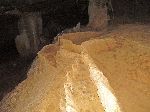
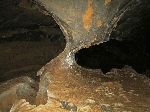
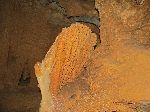
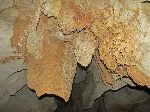
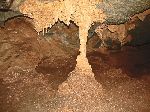 |
||
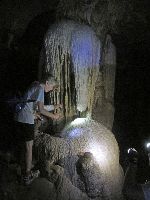
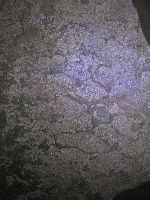
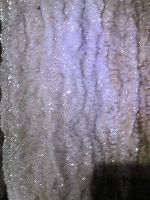
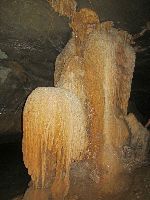
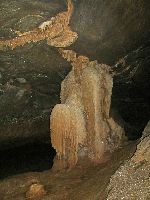 |
||
 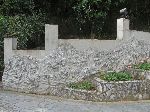 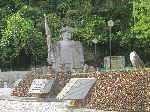 The
Malagones Memorial recognizes a 12 man militia that form in Pinar del
Rio, 1959, to support Fidel Castro's revolution. It was the first rural
militia to form after the revolution. The fought counterrevolutionary bands
that hid in the areas mountains. Each member of the group has their own
memorial. The large statue is Leandro Rodriguea Malagon, the leader. To the
side is a relief of the fighters. The
Malagones Memorial recognizes a 12 man militia that form in Pinar del
Rio, 1959, to support Fidel Castro's revolution. It was the first rural
militia to form after the revolution. The fought counterrevolutionary bands
that hid in the areas mountains. Each member of the group has their own
memorial. The large statue is Leandro Rodriguea Malagon, the leader. To the
side is a relief of the fighters. |
||
|
|
||
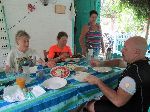 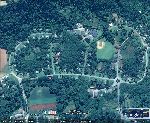 The
town of El Moncada was another of Fidel's ideas. The streets are
suppose to be laid out to form a C, U, B, and A. From an aerial view,
looking south, if you consider the connection between streets, houses,
vegetation and land use you can imagine this design. The housing has a
distinctly suburban feel, for an otherwise very rural area. The
town of El Moncada was another of Fidel's ideas. The streets are
suppose to be laid out to form a C, U, B, and A. From an aerial view,
looking south, if you consider the connection between streets, houses,
vegetation and land use you can imagine this design. The housing has a
distinctly suburban feel, for an otherwise very rural area.One of the houses is a paladar, serving meals on demand. |
||
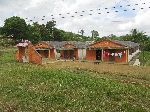 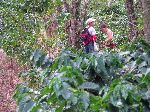 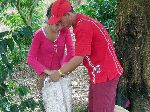 On
the edge of Moncada is an Escula el Campo (Campemento).
Escula el Campo is a program that moves students and professors to
the dorms in the countryside, for not more than a month a year, to learn
about different types of agriculture production and to help a variety of
farmers (state or private) with production. This is a principal from Jose
Marti that students should combine study and work for the best development
and to learn the values of working. We met students and teachers working on
the coffee harvest. On
the edge of Moncada is an Escula el Campo (Campemento).
Escula el Campo is a program that moves students and professors to
the dorms in the countryside, for not more than a month a year, to learn
about different types of agriculture production and to help a variety of
farmers (state or private) with production. This is a principal from Jose
Marti that students should combine study and work for the best development
and to learn the values of working. We met students and teachers working on
the coffee harvest. |
||
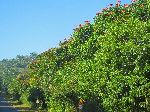 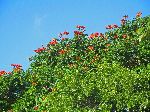 Spathodea
is a monotypic genus in the flowering plant family Bignoniaceae. The single
species it contains, Spathodea campanulata, is commonly known, in English,
as the African tulip tree, fountain tree, Nile flame, Uganda flame, squirt
tree, pichkari or Nandi flame. Common Spanish names are: amapola, espatodea,
mampolo, tulipán africanoThe tree grows between 7–25 m (23–82 ft) tall. It
is native to tropical dry forests of Africa, but because of its beauty it is
used as an ornamental all over the tropical world. There are hundreds in
this part of Cuba. Spathodea
is a monotypic genus in the flowering plant family Bignoniaceae. The single
species it contains, Spathodea campanulata, is commonly known, in English,
as the African tulip tree, fountain tree, Nile flame, Uganda flame, squirt
tree, pichkari or Nandi flame. Common Spanish names are: amapola, espatodea,
mampolo, tulipán africanoThe tree grows between 7–25 m (23–82 ft) tall. It
is native to tropical dry forests of Africa, but because of its beauty it is
used as an ornamental all over the tropical world. There are hundreds in
this part of Cuba. |
||
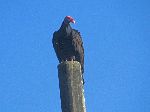 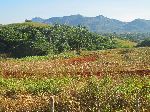 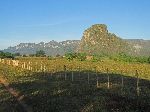 Turkey
vultures are present almost every place in Cuba. This one was kind enough to
pose. S/he seemed to be enjoying the same morning scenery that we were. Turkey
vultures are present almost every place in Cuba. This one was kind enough to
pose. S/he seemed to be enjoying the same morning scenery that we were. |
||
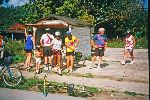
|
||
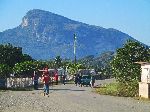 
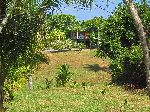

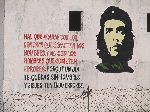 |
||
|
|
||
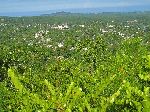   One
of my favorite towns is Minas de Matahambre. It sits in the hills with the main
parts of towns follows a series of wooded ridges that provide views of other sections of
town and the surrounding forest. Quaint, beautiful, delightful and a gem are not usual
adjectives for a mining town, but I would use them to describe Minas de Matahambre. One
of my favorite towns is Minas de Matahambre. It sits in the hills with the main
parts of towns follows a series of wooded ridges that provide views of other sections of
town and the surrounding forest. Quaint, beautiful, delightful and a gem are not usual
adjectives for a mining town, but I would use them to describe Minas de Matahambre. |
||
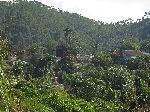   This
is an old copper mining towns. According to the current history, at the time of the revolution the mining
company virtually, and sometimes literally, worked their employees to death. Because
of this, the local citizen saw great opportunity in the Revolution. Though
the mines in town have closed, the town still has a noticeably high
concentration of signs, big and small, with revolutionary slogans, plus an
abundance of murals, statues, memorials and other public
art to demonstrate its spirit. This
is an old copper mining towns. According to the current history, at the time of the revolution the mining
company virtually, and sometimes literally, worked their employees to death. Because
of this, the local citizen saw great opportunity in the Revolution. Though
the mines in town have closed, the town still has a noticeably high
concentration of signs, big and small, with revolutionary slogans, plus an
abundance of murals, statues, memorials and other public
art to demonstrate its spirit.
As a counterpoint: Karen Georgens wrote us, "(I) lived in Minas de Matahambre for six years in the 50’s (through the Revolution) when my father was the general manager of the mine... When I read your article titled “Pinar del Rio: Mines and Pines,” I was taken aback by this statement: “At the time of the revolution the mining company virtually, and sometimes literally, worked their employees to death.” That is patently untrue. In fact, the miners were some of the most fairly treated and highest paid employees in the province. My father was solicited from northern Idaho to take the job because of his reputation and awards for mine safety and well-being of the miners that worked under him. He would never allow workers to “be worked to death” even if there wasn’t also a miners’ union to look after the miners’ best interests." |
||
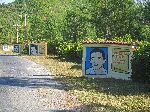

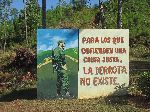
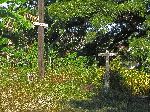
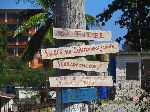 |
||
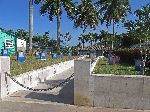


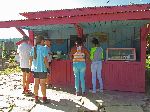
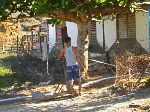 |
||
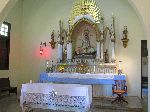 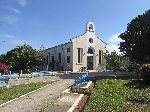  The
economy and curb appeal doesn’t reflect past hard times. The most prominent
building in town is the Catholic church, which is open and in excellent
condition. There is a library on main street. Forestry is now the largest
part of the local economy and new copper and gold mines have opened in the
area. The
economy and curb appeal doesn’t reflect past hard times. The most prominent
building in town is the Catholic church, which is open and in excellent
condition. There is a library on main street. Forestry is now the largest
part of the local economy and new copper and gold mines have opened in the
area. |
||
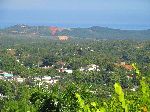 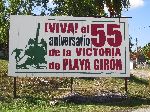 From
the ridges above the town you can see the ocean, and new strip mines. From
the ridges above the town you can see the ocean, and new strip mines. |
||
| Guane town seems to have a spring and energy to
it. Along the main street are dollar stores, book stores, a library, hotel, museum and
assorted other dry good stores. The only place I spent much time was the museum. The
director there clearly had a lot of pride in their small but well displayed collection and
enjoyed sharing it with visitors. Piece by piece she went through the history of island
from the indigenous population through the revolution. Most striking to me were the
pictures of housing before the revolution and what we were seeing now, riding at will all
over town. Even later in the day when I saw some less well kept houses, even the worse
weren’t at the level of a barrio or the condition generally seen in other less
developed countries. Cuba’s multiracial history is apparent everywhere, but elements of its racist legacy are no where. On the streets, on the job, on the dance floor there seems to be no reference to heritage. "African", "European", "white" and "black" are used to describe people but with no implications. I ask one of the "African-Cubans" who was part of the group, in a couple of different ways, whether is she identifies herself as "African-Cuban", whether whites felt like they had a different cultural as "European-Cubans" or whether white and black Cubans looked at themselves as being culturally different. She, with great politeness and poise seemed to be trying to figure out what the heck I was talking about. From the stratified and polarized society Cuba had thirty-five years ago, a "non-racial" society seems to be one of the great successes of the revolution. |
||
| Having been here for a week, had a few discussions, observed some behavior, seen a bit of at least Pinar del Rio, and dozen of hours of think while cycling rural roads give me a chance to reflect a bit about Cuba’s environmental practice. On some tallies Cuba ranks high on environmental policy. But what part of their success is a default not initiative? In sectors where the U.S. embargo or inept development policy might have had a role there seems to be greater level of environment-friendly practice: lot of organic fertilizer and a wide variety of non-motorized transportation. But less obvious are any widespread positive environmental initiatives. There is little use of: solar power (photo-voltaic, water heating) and wind power (a few rural wind mill for drawing water, but more in disrepair). Use of fluorescent lighting (especially in the light-intensive tourist hotels) is irregular. And recycling of aluminum cans (they are not using reusable glass for soft drinks and beer) and waste paper is unfortunately nil. | ||
|
One of the great part of the day was cycling along with our Cuban colleagues, have discussions about politics, history, current affairs and society. The offered thoughtful response through all phases of the conversation. In the evening the Cubans continued the dance lessons. They are determined that we all be able to salsa before we leave Cuba. |
||
|
|
||
    |
||
|
"Hosted by
DreamHost - earth friendly web hosting"
|
||
|
|
|

